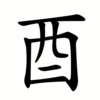酉
See also: 丣 and 西
| ||||||||
.mw-parser-output .character-sampledisplay:inline-block;min-width:1em;font-size:300%;text-align:center;background:rgb(0,0,0);background:rgba(0,0,0,0.1).mw-parser-output .character-sample>:only-childdisplay:block.mw-parser-output .character-sample-primarydisplay:inline-table;min-width:1.1em;font-size:300%;line-height:110%;text-align:center;background:rgb(0,0,0);background:rgba(0,0,0,0.1);height:1.1em.mw-parser-output .character-sample-secondarydisplay:inline-block;min-width:1em;text-align:center
Contents
1 Translingual
1.1 Han character
1.1.1 Derived characters
1.1.2 References
2 Chinese
2.1 Glyph origin
2.2 Etymology
2.3 Pronunciation
2.4 Definitions
2.4.1 Coordinate terms
2.4.2 Usage notes
2.5 Compounds
3 Japanese
3.1 Kanji
3.1.1 Readings
3.1.2 Compounds
3.2 Etymology 1
3.2.1 Pronunciation
3.2.2 Proper noun
3.3 Etymology 2
3.3.1 Proper noun
3.4 References
4 Korean
4.1 Hanja
5 Vietnamese
5.1 Han character
Translingual
| Stroke order | |||
|---|---|---|---|
 | |||
Han character
酉 (radical 164, 酉+0, 7 strokes, cangjie input 一金田一 (MCWM), four-corner 10600, composition ⿴西一)
Kangxi radical #164, ⾣.
Derived characters
- Index:Chinese radical/酉
References
- KangXi: page 1280, character 2
- Dai Kanwa Jiten: character 39763
- Dae Jaweon: page 1778, character 36
- Hanyu Da Zidian: volume 6, page 3572, character 1
- Unihan data for U+9149
Chinese
simp. and trad. | 酉 | |
|---|---|---|
| variant forms | 丣 | |
Glyph origin
| Historical forms of the character 酉 | |||||||||
|---|---|---|---|---|---|---|---|---|---|
Shang | Western Zhou | Spring and Autumn | Warring States | Shuowen Jiezi (compiled in Han) | Liushutong (compiled in Ming) | ||||
Bronze inscriptions | Oracle bone script | Bronze inscriptions | Bronze inscriptions | Bronze inscriptions | Chu Slip and silk script | Qin slip script | Ancient script | Small seal script | Transcribed ancient scripts |
 |  |  |  |  |  |  |  |  |  |
| Characters in the same phonetic series (酉) (Zhengzhang, 2003) | |
|---|---|
| Old Chinese | |
楢 | *kʰjuʔ, *lu |
逎 | *ʔslu |
遒 | *sklu, *sɡlu |
蝤 | *sklu, *sɡlu |
揂 | *sklu |
酒 | *ʔsluʔ |
媨 | *sklus |
鞧 | *skʰlu |
緧 | *skʰlu |
趥 | *skʰlu, *skʰluŋs |
酋 | *sɡlu |
崷 | *sɡlu |
鰌 | *sɡlu |
煪 | *sɡlu |
醜 | *l̥ʰjuʔ |
猶 | *klus, *lu, *lus |
猷 | *lu |
輶 | *lu, *luʔ, *lus |
偤 | *lu |
莤 | *lu, *sruɡ |
蕕 | *lu |
庮 | *lu, *luʔ |
槱 | *luʔ, *lus |
梄 | *luʔ |
丣 | *luʔ |
酉 | *luʔ |
Pictogram (象形): an ancient vase used in making and storing fermented millet alcoholic drink. See 酒.
Etymology
- “unitary”
- From English unitary.
Pronunciation
Definitions
酉
- an alcoholic drink vessel
- tenth of twelve earthly branches (十二支)
rooster (鷄) of Chinese zodiac- the period from 5-7 p.m.
(mathematics) unitary
Coordinate terms
- (earthly branches) 地支; 子, 丑, 寅, 卯, 辰, 巳, 午, 未, 申, 酉, 戌, 亥
Usage notes
Although it remains associated with alcoholic drink, the character alone is mostly used as the tenth earthly branch in the Chinese cyclical calendar.
Compounds
|
|
|
Japanese
Kanji
酉
(“Jinmeiyō” kanji used for names)
- "sake" radical (さけづぐり)
- "bird of the zodiac" radical (ひよみのとり, とりへん)
rooster (tenth sign of the Chinese zodiac)
Readings
Go-on: ゆ (yu)
Kan-on: ゆう (yū)←いう (iu, historical)
Kun: とり (tori, 酉)
Nanori: なが (naga); みのる (minoru).mw-parser-output .jouyou-readingbackground-color:rgb(224,255,255);background-color:rgba(224,255,255,0.5)
Compounds
卯 (ぼう)酉 (ゆう)線 (せん) (bōyūsen)
酉年 (とりどし) (toridoshi)
Etymology 1
Kanji in this term |
|---|
酉 |
とり Jinmeiyō |
kun’yomi |
From 鶏 (niwatori, tori, “chicken”), from 庭 (niwa, “garden”) + 鳥 (tori, “bird”)
Pronunciation
Kun’yomi
(Tokyo) とり [tòrí] (Heiban – [0])
IPA(key): [to̞ɾʲi]
- Homophones: 鳥, 鶏
Proper noun
酉 (hiragana とり, rōmaji Tori)
- the Rooster, the tenth of the twelve Earthly Branches
Etymology 2
Kanji in this term |
|---|
酉 |
ゆう Jinmeiyō |
on’yomi |
From Middle Chinese 酉 (yuwX)
Proper noun
酉 (hiragana ゆう, rōmaji Yū, historical hiragana いう)
- the Rooster, the tenth of the twelve Earthly Branches
References
|
|
- Source: EDICT and KANJIDIC files licensed by the Electronic Dictionaries Research Group.
Korean
Hanja
酉 • (yu) (hangeul 유, revised yu, McCune–Reischauer yu, Yale yu)
- This term needs a translation to English. Please help out and add a translation, then remove the text
rfdef.
Vietnamese
Han character
酉 (dấu, dậu, giấu, giậu)
- This term needs a translation to English. Please help out and add a translation, then remove the text
rfdef.
